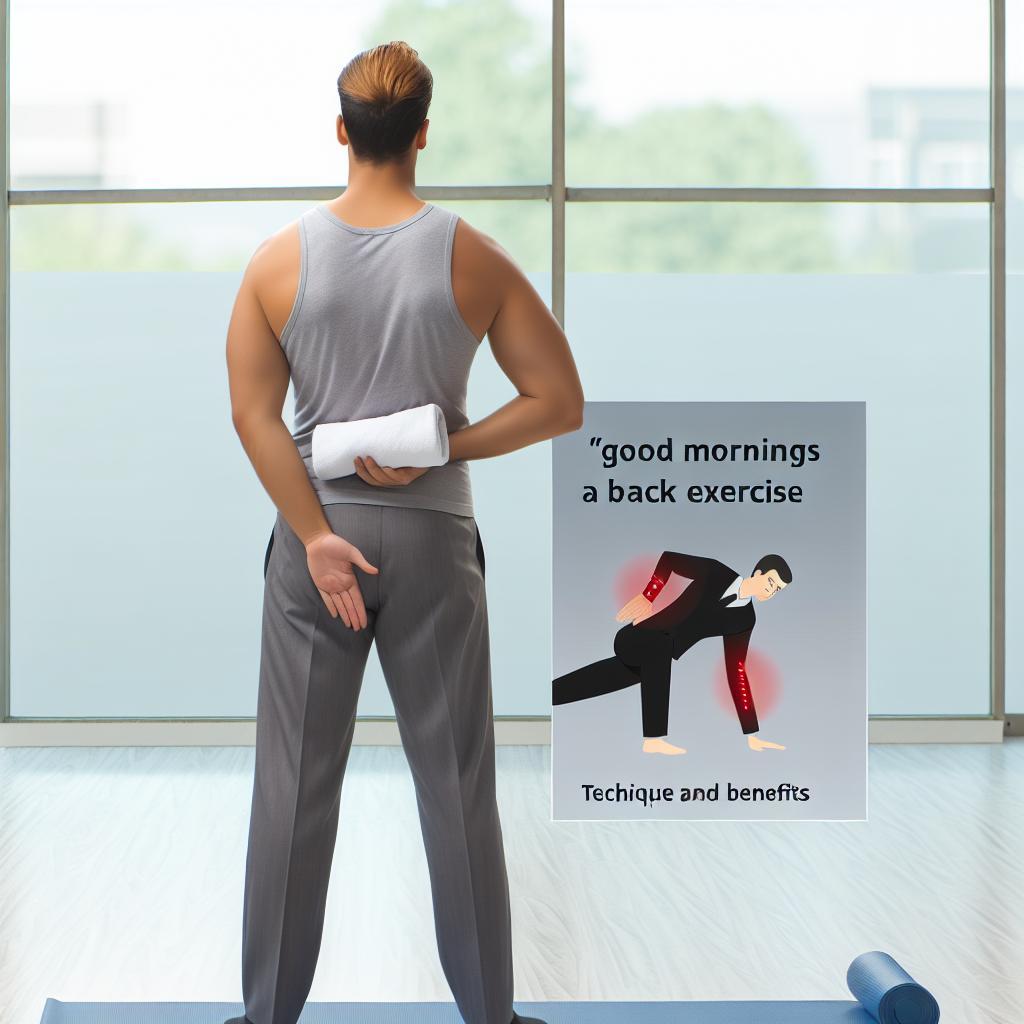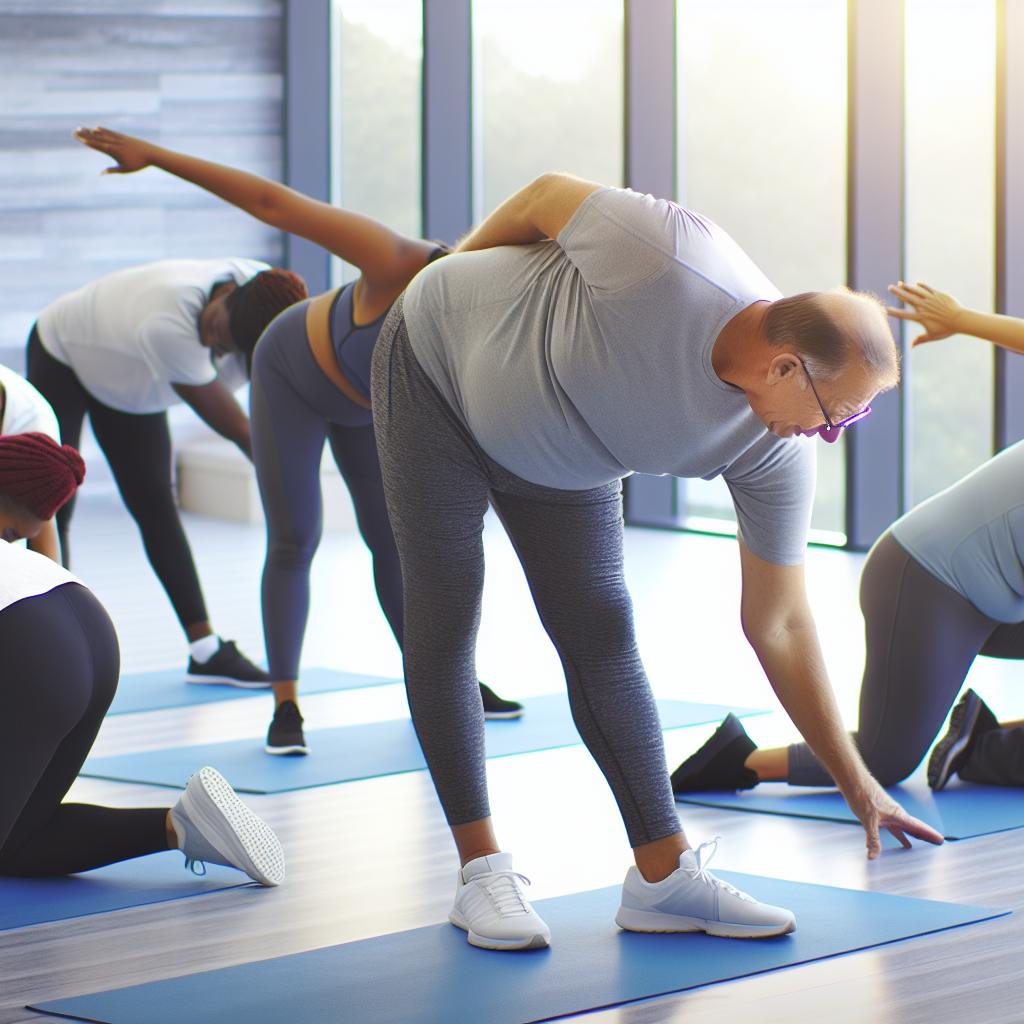Are you looking for a way to enhance your back strength while starting your day? Many wonder if good mornings, a popular exercise frequently enough associated with weightlifting, contribute effectively to back health. Understanding thier technique and benefits can transform your morning routine and support your fitness journey, making this topic both relevant and essential for anyone aiming for a strong back.
## Understanding Good Mornings as a Back Exercise: Technique and Benefits
Technique of Good Mornings
Good mornings are an excellent exercise for targeting the posterior chain, especially the lower back, glutes, and hamstrings. To perform good mornings safely and effectively, follow these essential steps:
- Starting Position: Stand with your feet shoulder-width apart, and place a barbell on your upper traps if using one. If you’re a beginner, start with just your body weight.
- Engage Your core: Keep your core tight throughout the movement to protect your lower back.
- Hip Hinge: Bend at the hips while keeping a slight bend in your knees, lowering your torso while maintaining a neutral spine.
- Range of Motion: Lower your torso until it’s almost parallel to the ground, or as far as adaptability allows.
- Return to start: Engage your glutes and hamstrings to return to the starting position by extending your hips, keeping your back straight.
Benefits of Good Mornings
Incorporating good mornings into your training regimen can offer numerous benefits, particularly for the back and overall strength:
- Strengthens the Lower Back: Engages and builds strength in the erector spinae, essential for maintaining proper posture.
- Enhances Hip Mobility: Encourages hip hinging and flexibility, aiding in overall functional movement.
- Improves Athletic Performance: A stronger posterior chain translates to better performance in sports and other strength training exercises.
- Supports Injury Prevention: Strengthening the lower back and hamstrings can reduce the risk of injuries associated with lifting and athletic activities.
Common Mistakes to Avoid
While performing good mornings, keep an eye out for these common mistakes to maximize effectiveness and minimize injury risk:
- Allowing the back to round during the movement.
- Using too much weight before mastering the technique.
- Not engaging the core adequately, which can lead to spinal strain.
Additional Tips
To further enhance your good mornings, consider incorporating the following:
- Start with lighter weights or bodyweight to ensure proper form.
- Gradually increase the weight as your technique and strength improve.
- Include stretches for the hamstrings and lower back in your warm-up routine to enhance flexibility.
## The Science Behind Good Mornings: Are They Effective for Your Back?
The Role of Good Mornings in Back Health
Good mornings are an excellent exercise for enhancing posterior chain strength, particularly targeting the hamstrings, glutes, and lower back. When performed correctly,they can improve overall back health by increasing flexibility and stability. This exercise specifically promotes proper spinal alignment, which is crucial for maintaining a healthy back. However, it’s essential to understand the mechanics and proper technique involved to reap these benefits efficiently and safely.
Proper Technique for Good Mornings
To perform good mornings correctly, follow these steps:
- Stance: Stand with your feet shoulder-width apart, holding a barbell across your upper back (traps) – not on your neck.
- Movement: Hinge at your hips, keeping your back straight and core engaged. Lower your upper body while maintaining a slight bend in the knees until you feel a stretch in your hamstrings.
- Return: gradually return to the starting position by pushing through your heels and engaging your glutes.
Benefits of Good Mornings for Your Back
Incorporating good mornings into your routine can lead to several benefits for your back, including:
- Increased Strength: Helps build strength in the lower back, which can reduce the risk of injuries.
- Enhanced Flexibility: Regular practice can improve hamstring and lower back flexibility.
- Improved Posture: strengthening the muscles involved supports better spinal alignment, improving your overall posture.
Safety Tips
To avoid injury while performing good mornings:
- Start with lighter weights to perfect your technique.
- Avoid rounding your back during the exercise; keep it neutral.
- Listen to your body; if you experience pain,stop and reassess your form.
Good Mornings in Your Routine
For optimal results, integrate good mornings into your workout routine 1-2 times a week. Combine them with other exercises targeting the core and lower body to enhance muscle balance and strength:
| Exercise | Sets | Reps |
|---|---|---|
| Good Mornings | 3 | 10-12 |
| Deadlifts | 3 | 8-10 |
| Plank | 3 | 30-60 seconds |
## Proper Technique for Good Mornings: Step-by-Step Instructions
Setting Up for Good Mornings
To perform Good Mornings safely and effectively, start by setting up your equipment correctly. Typically, you’ll want to perform this exercise with a barbell, but you can also use a lighter weight or even a resistance band for beginners. Hear’s how to set up:
- Stand with your feet shoulder-width apart.
- Position a barbell across your upper back, resting on the traps (do not place it on the neck).
- Engage your core and keep a neutral spine throughout the movement.
Step-by-Step Technique
Follow these steps to ensure proper movement and maximize the benefits of Good Mornings:
- Initiate the Movement: Begin by gently hinging at the hips. Push your hips back while maintaining a slight bend in your knees. Your torso should lean forward, but your back must remain straight.
- Lower Your torso: Continue lowering your torso until it is indeed nearly parallel to the ground, or as far as your flexibility allows.
- Engage Your Muscles: Focus on engaging your hamstrings and glutes as you lower your torso. Your head should remain in line with your spine to prevent strain.
- Return to Start: Slowly reverse the motion by pressing through your heels, returning to a standing position while squeezing your glutes at the top.
Key Tips for Success
- Maintain proper posture: Keep your shoulder blades back and down throughout the movement.
- control the movement: Avoid using momentum; ensure each rep is performed with purpose and control.
- Focus on breathing: Inhale as you hinge forward, and exhale as you return to standing.
Common Mistakes to Avoid
To maximize effectiveness and minimize injury risk, be mindful of these common mistakes:
- Rounding the Back: Always keep your back straight to avoid strain.
- Using Excess Weight: Start with lighter weights to master the form before progressing to heavier loads.
- Not Engaging the Core: Failing to activate your core can lead to poor posture and potential injury.
Benefits of Good Mornings
| Benefit | Description |
|---|---|
| Strengthens Posterior Chain | Effectively targets the hamstrings, glutes, and lower back. |
| Improves Hip hinge Mechanics | enhances your ability to perform other lifts such as deadlifts and squats. |
| Increases Flexibility | Helps improve overall flexibility in the hamstrings and hips. |
## Essential Benefits of Good Mornings: Why They Matter for Your Back
Improved Flexibility and Mobility
Performing good mornings regularly can considerably enhance your flexibility and mobility, particularly in the hamstrings, lower back, and hips. This stretch is essential for individuals who spend long hours sitting, as it helps to counteract tightness accumulated throughout the day. Stretching your hamstrings can lead to:
- Greater range of motion during exercises.
- Reduced risk of injuries.
- Improved overall athletic performance.
Strengthening Core Muscles
Good mornings primarily target the lower back and core, making them an excellent addition to your routine. by actively engaging your core throughout the exercise, you can strengthen the following muscle groups:
- Rectus abdominis.
- Obliques.
- Transverse abdominis.
instructions for a Safe and Effective Good Morning
- Stand with your feet shoulder-width apart,knees slightly bent,and weight evenly distributed.
- Place a barbell across your upper back (or use just your body weight to start).
- engage your core, maintaining a neutral spine as you hinge at the hips, lowering your torso until it’s nearly parallel to the floor.
- Pause briefly, then engage your glutes and drive through your heels to return to a standing position.
Enhancing Posture
Regularly incorporating good mornings into your routine can significantly improve your posture. By strengthening the muscles in your lower back and core, you can:
- Maintain an upright posture throughout the day.
- Minimize strain on your spine.
- Reduce the likelihood of developing back pain.
Key Points to Remember
| Benefit | Why It Matters |
|---|---|
| Flexibility | Counteracts tightness from sitting, enhancing movement. |
| Core Strength | Supports daily activities and reduces injury risk. |
| Improved Posture | enhances spine alignment and comfort. |
## Complementary Exercises: Maximizing the Benefits of Good Mornings for Your Back
Enhanced Flexibility with Hamstring Stretches
To maximize the benefits of Good Mornings, it’s essential to incorporate **hamstring stretches** into your routine. Tight hamstrings can reduce your range of motion and strain your lower back during the exercise. Here are effective stretches to consider:
- Standing Hamstring Stretch: Stand tall, lift one leg straight in front of you, and reach towards your toes while keeping your back straight. Hold for 15-30 seconds and switch legs.
- Seated Hamstring Stretch: sit on the floor with both legs extended. Slowly reach towards your toes while keeping your back straight. Hold for 15-30 seconds.
Strengthening Core Exercises
Building a strong core is vital for supporting your back during Good Mornings. Include these core-strengthening exercises:
- Plank: Maintain a plank position for 30-60 seconds, ensuring your body forms a straight line from head to heels.
- Bicycle Crunches: Lying on your back, bring your knees to your chest and alternate touching your elbows to opposite knees. Aim for 15-20 repetitions.
Complementary Lower Back Strengtheners
To further support your back,integrate specific lower back strengthening exercises into your regimen:
- Bird-Dog: On all fours,extend one arm forward and the opposite leg back,engaging your core. hold for a few seconds, then switch sides. Repeat for 10-15 reps.
- Superman Exercise: Lie face down, extend your arms and legs, and lift them off the ground concurrently. hold for a few seconds before lowering down. Aim for 10-15 repetitions.
Effective Workout Routine Table
| Exercise | Duration/Reps | Sets |
|---|---|---|
| Standing Hamstring Stretch | 15-30 seconds | 2-3 |
| Plank | 30-60 seconds | 3 |
| Bird-Dog | 10-15 reps | 2-3 |
## Common Challenges with Good Mornings: Considerations for Safe Practice
Understanding Common Challenges
Good Mornings can be an effective exercise for targeting the posterior chain,but they come with potential challenges that necessitate careful attention. Common issues include
- Improper Form: Many individuals struggle to maintain proper posture, which can lead to undue strain on the lower back.
- excessive Weight: Attempting to lift too heavy can compromise technique, increasing the risk of injury.
- Lack of Flexibility: Insufficient hamstring and hip flexibility can hinder movement and discourage progression.
Techniques for Safe Execution
To ensure safety while performing Good Mornings, it’s vital to focus on the following techniques:
- Maintain a neutral spine throughout the movement.
- Initiate the movement by hinging at the hips rather than bending at the waist.
- engage your core to support your lower back.
Injury Prevention Strategies
Incorporating a few key strategies can help mitigate the risks associated with Good Mornings:
- Stretch Beforehand: Engaging in dynamic stretching, particularly for the hamstrings and lower back, can enhance flexibility.
- Progress Gradually: Start with lighter weights and increase resistance only as you become more pleasant with the movement.
- Focus on Form: Consider recording yourself or using a mirror to monitor your technique during execution.
Recommended Warm-Up Stretches
Here are a few stretches to prepare your body for Good Mornings:
| Stretch | Description | Duration |
|---|---|---|
| Hamstring stretch | Reach towards your toes while standing or seated. | 30 seconds |
| Hip Flexor Stretch | Lunge position, pushing hips forward. | 30 seconds each side |
| Cat-Cow Stretch | Alternate between arching and rounding your back on all fours. | 1 minute |
## Addressing Discomfort: Actionable Techniques to Avoid Strain During Good Mornings
Proper Warm-up Techniques
Before attempting Good Mornings, it’s essential to engage in a proper warm-up to prepare your muscles and joints. Consider incorporating the following stretches:
- Cat-Cow Stretch: This dynamic stretch improves flexibility in the spine and warms up the back muscles.
- hip Flexor Stretch: Target the hip area to enhance mobility and reduce tension.
- thoracic Extensions: Using a foam roller can help improve upper back mobility, which is crucial for Good Mornings.
Technique Adjustments for Comfort
Utilizing proper form is vital to avoid discomfort during Good Mornings. Focus on these key adjustments:
- Foot Position: Keep your feet shoulder-width apart to maintain stability.
- Bar Position: The bar should rest on your traps, not your neck, to prevent strain.
- Hip Hinge Movement: Initiate the movement by driving your hips back, similar to closing a car door. This helps engage the posterior chain effectively.
staying Balanced
To further avoid strain, practice balancing exercises such as:
- Single Leg Deadlifts: This improves balance and strengthens the stabilizing muscles.
- Core Engagement: Focus on tightening your core throughout the movement to protect your lower back.
Listening to Your Body
It’s crucial to recognize the signs of discomfort versus pain. Follow these guidelines:
- Begin with lighter weights to assess your form and comfort level.
- Gradually increase the load while remaining mindful of your body’s response.
- Incorporate rest and recovery days to allow your muscles to heal and adapt.
## Stretches and Warm-Ups: Preparing Your Back for Good mornings
Essential Stretches for Your Back
Before performing Good Mornings, it is critical to prepare your back and surrounding muscle groups through specific stretches. Proper warm-ups will enhance flexibility and reduce the risk of injury. Here are some effective stretches to incorporate:
- Cat-Cow Stretch – This movement helps to mobilize the spine and engages both the back and abdominal muscles. Start on all fours, alternate arching your back upwards (Cat) and then dipping it downwards (Cow).
- child’s Pose - This stretch relaxes the lower back. kneel on the ground, sit back on your heels, and reach your arms forward while lowering your torso down.
- Torso Twist – stand with feet shoulder-width apart, gently twist your torso to one side and hold for a few seconds, then alternate sides. This improves spinal mobility.
Warm-Up Exercises to Activate Your Back Muscles
In addition to stretching, warming up specific muscle groups can optimize performance during Good Mornings:
- Hip Hinge Drill - Practice this movement without weights to ensure your hip movement is correct. Stand tall with feet hip-width apart,push your hips back,and lower your upper body while keeping your back straight.
- Glute Bridges – Lie on your back with knees bent and feet flat on the floor. Push through your heels to lift your hips,engaging the glutes and lower back.
- Wall Slides – Stand with your back against a wall and slide down into a squat, keeping your back flat against the wall. This helps in establishing a strong back posture.
Sample Warm-Up Routine
Here’s a concise warm-up routine you can follow to effectively prepare your back for Good Mornings:
| Exercise | Duration |
|---|---|
| Cat-Cow Stretch | 1 minute |
| Child’s Pose | 1 minute |
| Torso Twist | 1 minute (30 seconds per side) |
| Hip Hinge Drill | 2 minutes |
| Glute Bridges | 2 minutes |
| Wall Slides | 2 minutes |
Incorporating these stretches and warm-ups into your routine will not only prepare your back for Good mornings but also enhance overall performance and reduce the risk of injury. Always remember to listen to your body and adjust the intensity as needed.
## Incorporating Good Mornings into Your Routine: Practical Tips for all Skill Levels
Understanding the Good Morning Exercise
The Good Morning exercise is a fantastic addition to any workout routine.Primarily targeting the hamstrings and lower back, it also engages your core, making it a versatile move suitable for all skill levels. Here are some key aspects to keep in mind:
- Muscle Engagement: The exercise strengthens the posterior chain, which is crucial for overall stability and posture.
- Flexibility Improvement: Regularly incorporating Good Mornings can increase flexibility in the hamstrings and lower back, enhancing your range of motion.
- Low Impact: This exercise can be performed without heavy weights, making it accessible for beginners.
Step-by-Step Technique
To incorporate Good Mornings into your routine safely and effectively,follow these steps:
1. Positioning
- Stand with your feet shoulder-width apart, and place a barbell across your shoulders. If you’re a beginner, start with no weight.
- Engage your core and keep your chest up.
2. The Movement
- Begin by bending at the hips, pushing your hips back while maintaining a slight bend in the knees.
- Lower your torso until it’s parallel to the ground, keeping your back straight. Aim for a comfortable stretch in your hamstrings.
- Reverse the movement by driving your hips forward to return to the starting position.
Tips for All Skill Levels
| Skill Level | Tips |
|---|---|
| beginner | Start without weights. Focus on maintaining proper form before adding resistance. |
| Intermediate | Add light weights to challenge your muscles but ensure you can still maintain proper form. |
| Advanced | Utilize heavier weights while practicing controlled movements, and consider incorporating variations such as single-leg Good Mornings for added challenge. |
By following these guidelines, you can effectively incorporate Good Mornings into your routine, reaping the benefits of strength, flexibility, and overall fitness. Remember to listen to your body and adjust the intensity and repetitions according to your skill level.
Faq
### Are Good Mornings Primarily a Back Exercise?
Good mornings are often classified as a lower body and core exercise, but they significantly engage the muscles of the back as well. This exercise primarily targets the **hamstrings, glutes**, and **lower back**, making it a compound movement that enhances overall posterior chain strength. The lower back muscles, particularly the **erector spinae**, are heavily involved as they work to stabilize the spine during the movement.By performing good mornings with proper form,you can develop both flexibility and strength in the back. The importance of this cannot be overstated, as a strong back is essential for good posture and daily functional movements. It is also beneficial for athletes and anyone who engages in physical activity, as improved back strength aids in injury prevention and enhanced performance.
### What is the Proper Technique for Good Mornings?
To perform good mornings correctly, follow these steps:
1. **Setup:**
- Stand with your feet shoulder-width apart.
– Place a barbell across your upper back, not on your neck—use a stable grip with your hands just outside your shoulders.
2. **movement:**
– Keep your chest up and your back straight; hinge at the hips rather than bending at the waist.
– As you bend forward, push your hips back while allowing your knees to bend slightly.
- Lower your torso until it is parallel to the ground or slightly beyond, ensuring that your back remains straight throughout the movement.
3. **Return:**
– Engage your glutes and hamstrings to pull yourself back to the starting position. Make sure to rise with control, returning to an upright posture.
**Key Points:**
– Maintain a neutral spine throughout the movement.
– focus on activating your glutes and hamstrings during the lift.
– Avoid rounding your back to prevent injury.
Practicing good form will help ensure that you maximize the benefits of the exercise while minimizing the risk of injury.### What Are the Key Benefits of Doing Good Mornings?
Good mornings offer a variety of benefits that make them a valuable addition to any fitness program:
– **Strength Development:** Primarily, they enhance the strength and endurance of the posterior chain, which includes your glutes, hamstrings, and lower back muscles.
– **Improved Flexibility:** Regularly performing good mornings can lead to improved flexibility in the hip and back areas,which is crucial for overall movement quality and reduces the risk of injuries.
– **Core Stabilization:** This exercise requires core engagement, which helps develop abdominal strength, aiding in overall stability and balance.
Additionally, good mornings can facilitate better movement patterns. For instance, they mimic the hip hinge commonly found in various sports and exercises such as deadlifts and squats. This reality means that if you integrate good mornings into your routine, you’ll not only strengthen your muscles but also improve your ability to perform other lifts more effectively.
### Can Good Mornings Help with Posture?
Yes, good mornings are great for enhancing posture. Poor posture is often linked to weak back muscles, particularly in the upper and lower back regions. By strengthening these muscles through good mornings, you can create a more balanced musculature, which promotes better alignment of the spine.
Additionally, good mornings help you develop awareness of your body’s positioning. as you perform this exercise, you learn to maintain a neutral spine and engage key muscle groups, which translates to improved posture both in and out of the gym.
To maximize this benefit,combine good mornings with other back-strengthening exercises like bent-over rows or planks,which can further support and reinforce good posture.
### Who Should Avoid Performing Good Mornings?
While good mornings can be beneficial for many, certain individuals might need to avoid or modify this exercise:
– **Existing Back Injuries:** If you have a history of back problems, such as herniated discs or severe muscle strains, consult with a healthcare professional before attempting good mornings.
– **Improper Form:** Beginners may struggle with maintaining a neutral spine, which can lead to injury. If you’re unsure about your technique, consider working with a trainer to develop proper form first.
Additionally, if you experience pain during the exercise, it’s crucial to stop promptly. Always listen to your body and progress at a pace that feels right for you.
### How Should Good Mornings fit into a Workout Routine?
Integrating good mornings into your workout routine can be done in several ways:
– **Strength Training Days:** Incorporate good mornings on lower body or strength days, as they complement exercises like squats and deadlifts well.
– **Supersetting:** Pair good mornings with exercises targeting other muscle groups,such as push-ups or bench presses,for efficient training.
– **Warm-Up Routine:** Use lighter weights for good mornings as part of a dynamic warm-up to prepare your posterior chain for heavier lifting.Aim to include good mornings in your routine 1-2 times a week, allowing time for recovery between sessions. This frequency helps ensure that your muscles develop strength and endurance without overwhelming them. Remember, consistency is key to seeing results.
Wrapping Up
### Wrapping It Up: Embracing Good Mornings as a Back Exercise
integrating good mornings into your fitness routine can yield notable benefits for your back, posture, and overall strength. Remember,consistency is key to reaping these rewards!
#### Key Takeaways
– **What Are Good Mornings?**
A functional exercise focusing on your posterior chain,emphasizing the back,hamstrings,and glutes.
– **Technique Matters:**
Proper form is essential to avoid injury. Focus on:
- Keeping a straight back
– engaging the core
- Maintaining a neutral spine throughout the movement
– **Benefits of Good Mornings:**
– Improves backside muscular strength
– Enhances flexibility in your hips and hamstrings
– Aids in better posture
#### Action Steps
1.**Start Slow:**
If you’re new to this exercise, practice with body weight first to master the form.
2. **Progress Gradually:**
Once comfortable, add weight to increase difficulty – but prioritize technique over the amount of weight.
3. **Incorporate Regularly:**
Aim to include good mornings in your workout routine 1-2 times a week for optimal results.
### Encouragement for your Journey
No matter your current fitness level, good mornings can be a fantastic addition to your routine. they’re simple yet effective, and with patience and practice, you’ll notice improvements in your strength and flexibility.
Stay committed, listen to your body, and enjoy the process! Your back and body will thank you for it. Happy lifting!










